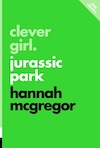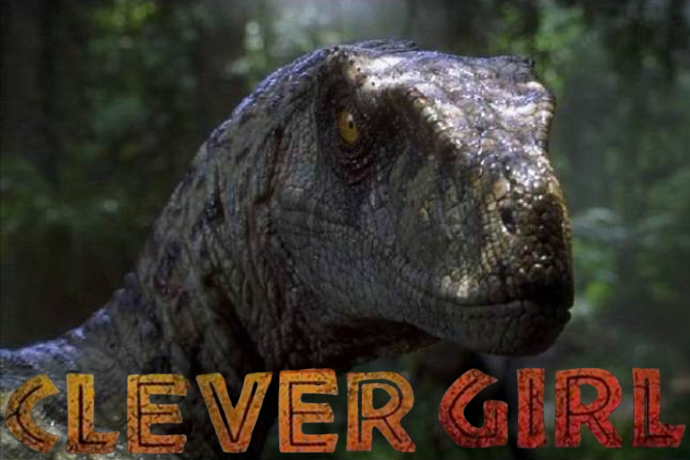Everything happens so much these days, and so very much of it is very bad indeed. In the last few weeks alone, we’ve had another school shooting, the passing of a social justice icon, the VP’s ‘cleansing’ visit to Dachau, and an ongoing genocide in Gaza despite the promised ceasefire.

Clever Girl: Jurassic Park
Hannah McGregor
ECW Press
Oct, 2024
So here’s the conversation I had with Dr. Hannah McGregor—public scholarship pathbreaker, style icon, and among my favorite people on the internet. We talked about their new-ish, emphatically awesome book, Clever Girl: Jurassic Park, and why female dinosaurs might just help us become our angriest, freest, most monstrous selves.
(This interview has been edited for length and clarity.)
What made you want to write about Jurassic Park? And what makes Jurassic Park such a cult classic?
I really think it has a lot to do with humans’ relationship to dinosaurs, and particularly with how that relationship began shifting in the wake of the 1970s Dinosaur Renaissance, or Paleontology Renaissance. Until the 1970s, paleontology had sort of fallen out of favor as a science. People were like: We know what we need to know about dinosaurs. They were here. They were big. Victorian and early 20th century fossil hunters, funded by big museum guys, found some big, cool fossils. They put them in museums. Everybody looked at them and said, look at these wild things. No wonder they went extinct. Too big. Nature, but too much.
There’s this general cultural understanding that dinosaurs were stupid, slow, lumbering, cold-blooded, and sort of inevitably went extinct because they were part of an old version of the earth that needed to be replaced with this superior species. It’s a teleological understanding of evolution.
But in the 1970s this new generation of paleontologists starts finding new kinds of fossils, and their ability to gather information about those fossils increases. With new technologies emerging, we learn that dinosaurs hunted in packs. They were probably intelligent. They had family units. There’s evidence that they cared for their young. These understandings reshape the whole notion of dinosaurs.
This is around the same time that paleontologists began theorizing that dinosaurs evolved into birds—and also that dinosaurs weren’t wiped out by God in a single fell swoop, but actually could have continued to exist in a different form. That really shifts our collective cultural imagination around dinosaurs, which leads to a surge in dinosaur media in the 1980s and 1990s. This media is grappling with our emergent knowledge that dinosaurs were animals with complexity. Media about human/dinosaur encounters ask us what happens when we come face-to-face with something that is intelligent and that in no way recognizes or respects our so-called supremacy.
Jurassic Park is about an attempt to control dinosaurs that fails in spectacular fashion. But so many of the most powerful moments in the movie are when humans and dinosaurs come face-to-face, and that sense of encounter with the sublime—of something that is bigger than you and that is so old. Something that comes from a version of Earth millions and millions and millions of years old, placing humanity in a much wider perspective, making us feel much, much smaller.
I was actually working overtime to try to figure out how I could shoehorn religion into this, even though it’s not strictly necessary. But this is a slam dunk, because this is exactly how Rudolf Otto theorizes the divine. He calls it the mysterium tremendum, an encounter with something so completely other that it fractures the self.
Yes! These moments when we see our characters in Jurassic Park encountering dinosaurs for the first time are undeniably spiritual moments. The first time Alan Grant sees dinosaurs? He cries; he falls to his knees. “They do move in herds,” he exclaims in wonder. It’s this sense of, “I’ve been studying this thing from afar, and now I get to be up close to it, and the things that I theorized about it, I now get to actually see.” And that proximity is terrifying, but it’s also awe-inspiring.
I was absolutely swept up in the dinosaur craze of the early 80s, but I never thought of Jurassic Park as particularly queer or particularly feminist. Clearly I was wrong. So help me. What’s queer, what’s feminist, about a movie about Big Dinosaurs?
A detail people often forget is that the scientists at Jurassic Park engineered all of the dinosaurs to be female because their understanding was that would make the dinosaurs more controllable, and specifically that it would make it impossible for them to reproduce, because controlling their capacity for reproduction becomes a way of controlling the population as a whole.
Oh, yeah. I just vividly remember them saying, “We used frog DNA.” At the time I kept thinking, “I had three minutes of biology in college, and even I know that frogs switch genders.”
Right! But their fantasy of control—and specifically reproductive control—is the source of their hubris. Jurassic Park is about understanding the female body as inherently controllable. And the scientists are proved comically wrong. They obviously have never read any feminist utopias, because women are having babies without men all the time in those stories.
And honestly, why even have technology if you can’t get rid of men?
[moment of misandrist silence]
Reading deeper into the film, the dinosaurs are these monstrous women caged in a system created by men to profit off them and control their reproduction. And they rise up! They literally tear down the fences. They eat the men who are trying to cage them, and they reproduce. It’s unauthorized reproduction.
Welp, there’s our feminist reading.
Undeniably. Now let’s add in the fact that the dinosaurs have been engineered to be female, but they’re not. The dinosaurs are actually intersex. The process of changing sex in a same-sex environment—as with frog DNA—is referred to as dichotomy. Dichotomous living things aren’t one sex or another; they can play either role in the reproductive process. So we’ve got this further destabilization of the heteropatriarchal logic through which the scientists are trying to control these creatures.
We’ve got all of these moments that wink at the queerness latent in this. One of my favorites is when they’re lowering the helicopter to first land in Jurassic Park, and John Hammond tells everybody to fasten their seat belts. Dr. Grant only has two same sides of a seat belt—colloquially known as the “female” ends—and has to knot them together.
I…wow. Laura Dern’s line about “woman inherits the earth” is right there in your face, but I completely missed the seatbelt scissoring.
But for me, maybe the queerest moment is when the big game hunter, Muldoon, realizes that while he’s been busy hunting one of the velociraptors, the other one has come in at his side. Right before she eats him, he says, “Clever girl.” Because for me, one of the defining features of queer community is having the things about you that you’ve been told are too monstrous be celebrated instead.
Oh, I love that—seeing ourselves reflected in unapologetically monstrous creatures is so satisfying! In your introduction (“On Looking at Dinosaurs and Dinosaurs Looking Back”), you play with Laura Mulvey’s concept of the gaze; I taught a class on religion and the monstrous feminine, and find myself coming back often to the way Linda Williams builds on Mulvey to argue that women and monsters share a special relationship, because women see themselves reflected in monsters.
The kind of reading you’re offering of Jurassic Park is, to me, so central to queer belonging, queer self-making. Finding yourself in stories where people didn’t imagine you, but you know you’re there anyway. So my first thought when I opened your book was, “What about me as a queer lady monster? Can I see myself in that dinosaur?” Turns out: very yes.
Oh yeah, in everything about them! They’re so, they’re so magnificent and they’re just constantly praised for being huge and vicious and hungry and uncageable.
Who is this book for? I can think of a number of audiences, but who are you hoping to reach with this?
My very favorite thing to do is to pick up a gem of beloved popular culture and turn it around to show fans how it can catch the light in ways you might not have noticed before. And if along the way, I, you know, indoctrinate you into feminist politics or accidentally turn you queer or make you gay? You’re welcome!
When I wrote Clever Girl, I was thinking about other people who love Jurassic Park and saying, look at the other ways we can use this story that so many of us already feel really connected to. We can put it to more radical use. But the book is also for other queer feminists out there looking for more things to put in your apocalypse survival toolkit.
Speaking of, your book promises that we can use Jurassic Park as a toolkit for the apocalypse. Now seems like a great time to talk about apocalypses and queerness and gender and survival.
One of the really key points for my thinking in this book is making explicit the difference between an apocalypse and an eschatology. Apocalypse is a radical transformation of the world, after which it can never be the same—but it’s not an ending. Kim Tallbear theorizes that Indigenous people are multiple generations into an apocalypse, and that when we talk about the apocalyptic nature of the present moment, we need to understand that we’re not experiencing apocalypse in the same temporality. Apocalypses can overlap in these complex, noncontinuous temporalities.
Jurassic Park is one of the stories that really accompanied me through the experience of my mother’s death, which was its own kind of apocalypse. A transformation after which the world is never the same again. After she died, I got really into plate tectonics and geology. I was so excited by the idea of geological time and understanding that when we look at the Earth from a massive span, it’s actually apocalypse after apocalypse after apocalypse. The transformations are massive and violent and destructive, and they’re never the end of anything.
For me, in a moment of personal apocalypse, that was deeply comforting—it might feel like everything is ending, but it’s not. It will never go back to normal. You’ll never be the same. But apocalypses aren’t endings.
We build things in the wake of them; possibilities flourish in the wake of them; there’s something on the other side. As I navigate living in this current, profoundly apocalyptic moment, stories like Jurassic Park—stories that are about what comes out the other side—are part of my toolkit. Things get the absolute worst they possibly can, and then there’s something on the other side. And it might not be us! But there’s something.
The way you’re framing apocalypse as a space of both deep mourning and unfathomable creative potential is really appealing there.
Final question: Why does this matter? Why does it matter that dinosaurs are queer and feminist and that this story is so beloved and that there’s so much potential in it?
For me, it comes back to the fact that queer and trans people have always been here. And then to have biologists come along and say “Hey guys, guess what? There’s absolutely not only two sexes. There never has been.” Nature is unbelievably fucked up and weird in many ways and for me, Clever Girl is an extension of that.
Everything has always been gay. This is not, I assure you, a recent trend! And of course I’m saying this to the Dinosaur Gays [editor’s note: we are legion], but also to the mainstream fans of this family-friendly, straight-man-directed (and -written) action blockbuster that many of us have loved since childhood. It’s hard to get more mainstream and wholesome than Spielberg. In many ways, he is American cinema. And this beloved film of his? Is gay. Not even secretly gay. Gay the whole time, but you just didn’t know how to look at it.
For me, reading your queer feminist self into these stories really is a survival strategy. It’s an apocalyptic toolkit, certainly—but also we queer people have been here the whole time, living. We didn’t come from nowhere, and there’s not an end to us. The future is queer. The past was queer.
It’s all just so queer.


